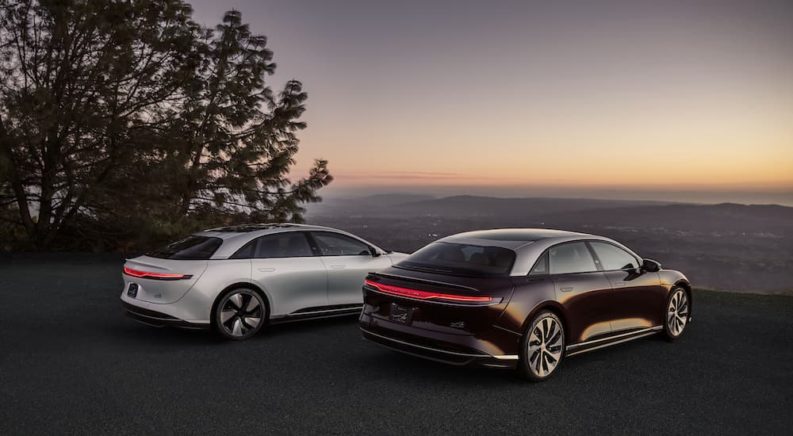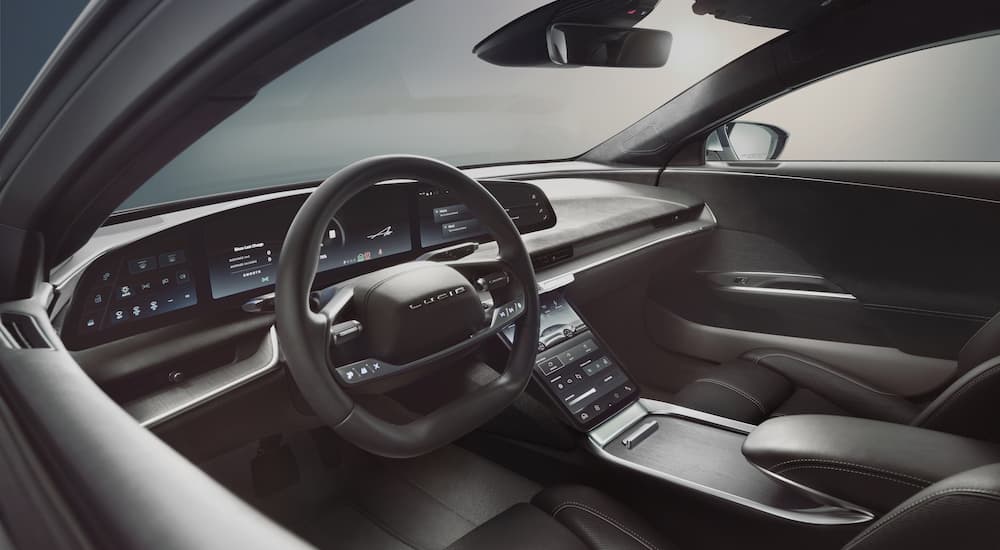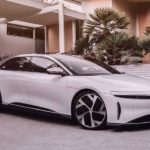There are two kinds of people: Jedi who do not deal in absolutes and Sith lords with access to unlimited power. In a similar manner, there are two kinds of BEV (battery-powered electric vehicle), those from established legacy automakers and start-ups. Beyond that oversimplification, EVs are taking on increasingly diverse forms––though they started as super sports cars and function-first appliances, they now form ranks of luxury sedans, compact crossovers, and pickup trucks! The Lucid Air Grand Touring Performance edition is the latest addition to the crowd, and it isn’t slotting in quietly somewhere in the middle––this luxury sedan from an Arizona start-up rushes right to the top of the power pile!
Almost every EV seems to make a lot of noise––not actual noise, media noise. Start-ups are particularly interesting thanks to Tesla’s rousing success, but one need not look further than Lordstown Motors to understand why skepticism is warranted until deliveries are being made and promises kept. Rivian’s score as “truck of the year” might therefore be premature, but for Lucid Motors, which started delivering the Air Dream Edition last fall, the “car of the year” title feels presciently right on time.
Lighter Than Air, It Is Not
The Lucid Air is many things, but lightweight isn’t one of them. Every version is a distilled manifestation of luxury and power––current models are built and priced to compete with the likes of the Porsche Taycan, Mercedes EQS, and of course, the Tesla Model S Plaid. The 1,111 hp of the new Lucid Air Dream Performance edition makes it the most powerful EV currently on sale in North America, easily making up for its 5,000 lb plus curb weight to make it quick as the wind––its 2.4-second 0-60 mph time is world-class! The cavernous interior offers completely uncompromised rear legroom, and a huge panoramic glass roof provides a comfortably airy atmosphere.
But the most impressive thing about the Lucid Air, in any guise, is the range. No rival other than Tesla offers more than 400 miles of range, yet the Air’s worst offering to date is the new Grand Touring Performance which features a range of 446 miles. The top-of-the-line Dream Range cracks 520 miles! This is incredibly impressive. I know, the Hummer EV proves that you can make an entire building go 0-60 in 3 seconds and still drive to the beach and back if you throw enough battery at it (bigger battery = more charge = more range, all other things being…equal). But the Air doesn’t subscribe to the theory of simply using a bigger energy reserve––instead, the Lucid Air is as efficient as nature permits.
Getting Their Priorities Straight
I once had a classmate who subscribed to the Lotus theory of “simplify, then add lightness” to such a degree that he machined the heads off bolts to shed grams on a gravity-powered car design. Every component was analyzed to determine the minimum mass needed to accomplish the task, and each was machined and filed down to the breaking point. The result was an untouchably effective car that easily won the class-wide competition.
Likewise, Lucid has identified the true key to making the most of a battery-powered vehicle. The point is to conserve resources, not pour half of the world’s lithium supply into a limited-run production vehicle. Recognizing this, Senior VP of Product and Chief Engineer Eric Bach directed one of the most thorough efficiency optimization efforts the industry has ever seen to make the absolute most of its 118 kWh battery pack (bigger than the 100 kWh pack in a Tesla Model S, but much smaller than the 210 kWh behemoth in the Hummer EV).
In an interview with InsideEV’s Tom Moloughney, Bach detailed the effort as a four-pronged battle to optimize aerodynamics, rolling resistance, auxiliary system management, and powertrain design. Like my classmate’s relentless pursuit to remove weight, virtually no aspect of the Lucid Air’s design was exempt from the efficiency-first philosophy.
Aerodynamics
Every performance or efficiency-oriented vehicle pays strong attention to aerodynamics. The less energy that gets sucked up by drag, the less energy is needed to cover those miles––simple, right? But minimizing drag is a game of diminishing returns. It takes significantly more effort to bring a vehicle from a drag coefficient of 0.25 to 0.2 than to go from 0.5 to 0.25. Of course, significantly more effort is exactly what Lucid delivered––what else would you expect when the head of aerodynamic design is Jean-Charles Monnet from Red Bull’s 4-peat World Champion Formula 1 team?
The narrow and shallow design presents a low front area, minimizing the amount of air that the Air displaces (this generally has a larger effect on total drag force than the drag coefficient but is less advertised by manufacturers). Vents on the front are not for cooling the brakes or motor––they are strategically placed to relieve high pressure by letting air flow through the body and out of side vents below the mirrors. Even the battery gets involved, with a diffuser that begins below the pack to allow a smoother, more gradual profile than is typical, making the feature more effective at sustaining what is known as “attached flow” across the underbody and at the tail end of the car.
The result is a wind tunnel-confirmed cd of 0.200, making the Air one of the most aerodynamic production cars ever, rivaling oddities like the GM EV1 and VW XL1. And yes, the Mercedes EQS is claiming the same drag coefficient, but it caps out around 350 miles of range. Minimizing drag is important, but clearly, aero isn’t everything.
Rolling Resistance
The energy that goes into rotating components is energy that does not go into moving you forward. A certain degree of this is necessary––rotating tires and driveshafts are obviously essential to modern automotive designs. But finding ways to minimize the energy they soak up––and more importantly, minimize the energy they lose due to rolling resistance––can lead to significant efficiency gains!
The most obvious place to do this is the tires. Anybody who’s ever swapped between summer and winter tires can attest to how much energy the winters seem to suck from your ride. The soft rubber, high-grip tread, and even the resulting noise all constantly bleed energy, contributing to reduced fuel efficiency. So it would make sense if you were a start-up developing a high-end luxury EV maximizing efficiency to collaborate with an established industry expert to design a bespoke tire to meet your exact requirements––which is exactly what Lucid did.
For the first time, a major tire manufacturer––Pirelli in this case––has developed a bespoke tire for an EV. While this is common for high-performance sports cars, the practice hadn’t trickled down to EVs until now! According to Pirelli, the new HL (High Load) version of the P ZERO tire “is able to support 20% more weight compared to a standard tire and 6-9% more weight than an extra load XL tire of the same size” in order to better-handle the mass of the big EV. Proprietary technologies like Pirelli Elect (for low resistance and superb grip) and PNCS (for reduced noise) are incorporated to deliver what the Air demands: efficiency, performance, and comfort.
That’s all awesome, and it’s easily the biggest way to impact rolling resistance, but if you’re going all-in, you can’t stop there. So Lucid didn’t stop there. It looked at all those other rotating components, sucking up momentum and generating friction, and optimized them all to minimize those friction losses. This even included every rotating component of the electric motors themselves.
Auxiliary Systems
“Auxiliary Systems” is one of those things that a “normal” person would never think of––or they would, but not realize that it probably doesn’t present enough opportunity for improvement to be worth re-engineering for efficiency. Unless you’re Lucid.
Everything inside the cabin that isn’t essential to moving the vehicle forward––the radio, ambient lighting, outlets, powered seats, and all the little controllers in charge of them–falls under the umbrella of auxiliary systems. These systems are connected by a 12 V electrical architecture which was designed in-house, allowing Lucid to optimize the energy consumption of those controllers and associated systems, but what stands out most has to be the headlamps!
The name is a mouthful: Intelligent Micro Lens Array LED Headlights. The unique system is composed of thousands of “light channels” projecting LED light through a collimator for concentrated, directional output, making them extremely bright, highly precise, and superbly controllable. The best part is that by taking the LED output and focusing it this way, these lamps can illuminate more with less, making them even more efficient than your typical LED headlights.
The Powertrain
Hoo boy, here we are––the powertrain! From the transmission to the motors to the battery pack itself, every part of the energy transformation system was designed, developed, and manufactured in-house for total optimization in the name of efficiency.
The battery pack gets a special and weird mention because technically, it isn’t part of the powertrain––it’s the equivalent of a fuel tank. Its only contribution to efficiency comes from how it behaves under extreme loading when resistance leads to heat build-up and exponential degradation effects––think of what happens to your gasoline engine fuel economy when you run it at the limit all the time. That being said, Lucid optimized the battery anyway, negating much of the power loss––worth up to 100 hp––that is typical under high load conditions and improving the regenerative capability of the system.
But the drive unit is the real star of the show. Developed entirely in-house and miniaturized for easy transplantation into any design, the 670 hp motor/transmission/differential/inverter combo kit is a showcase in obsessive engineering. These guys even optimized the magnetic field that rotates through the stator to be more efficient, with tons of copper in places where the magnetism is high and slots for cooling added wherever the magnetism is low. Enabled by simulation of the magnetic field behavior, Lucid has eliminated or strongly reduced losses experienced by other manufacturers who don’t control their designs so tightly.
They also focused heavily on cooling. The Air employs an extremely high voltage architecture, which enables industry-leading charge rates and reduces the current needed to generate a given amount of power, thereby significantly reducing energy lost to resistance. Lucid used silicon carbide for its switching devices which operate at a frequency of 10 kHz, each generating a tiny amount of heat 10,000 times per second. This material choice reduces the conductive and heat losses inherent to these devices, and cooling them with (you guessed it) an in-house-developed heat sink reduces the energy losses even further.
Lucid even redesigned the teeth of the freaking transmission gears! Regular old gears weren’t good enough for Lucid; no, they had to reduce friction by changing the design of the gear tooth profile. The gears! One of the most fundamental, ubiquitous, supposedly-uniform design features of automobiles, and they completely redesigned it. Virtually nothing was good enough as it was, and the result is long range from a relatively low mass battery pack, thereby consuming fewer resources to build the car and having a smaller carbon footprint, all while having better range and performance than most ICE-powered cars and virtually every other EV.
Lucid Air: the EV Heir
Lucid has taken the Tesla strategy to a whole new level, starting out with a high-cost, high-performance EV that genuinely competes at its price point and sets the stage for more accessible models to promote the widespread adoption of sustainable EVs. This latest announcement regarding the Grand Touring Performance edition is exciting for 1) essentially re-introducing the Dream Edition sans a few horsepower and the Santa Monica interior design theme and 2) for the proof of a successful product launch that comes with it. With Dream and Grand Touring models currently being built, we can finally believe that this is going to work! Of course, after all the effort spent to ensure the Air’s industry-leading efficiency, why shouldn’t we?






